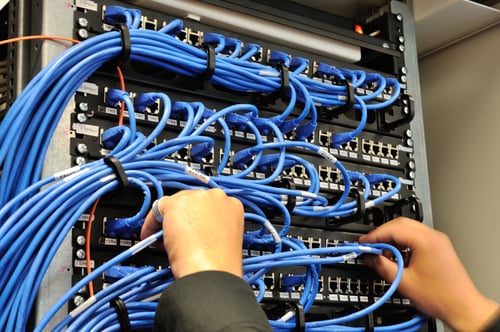The Three S's of Structured Cabling: Standardization, Scalability, and Stability

Structured cabling is the backbone of modern communication networks, providing the foundation for seamless connectivity and efficient data transmission.
The Three S's—standardization, scalability, and stability—play a crucial role in ensuring the success of structured cabling systems.
Structured cabling systems are relied on more than ever in today’s digital-first world as data centers are tasked with keeping up what seems like a seemingly insatiable appetite for data.
“The speed, reliability, and quality of your data center’s network connections will affect online transactions of all kinds-digital and analog communication, website execution, volume of input and output operations to disk storage, internet throughput, and critical transactions to databases, applications, and high-performance computing-essentially impacting all data center network connectivity,” explains Kevin Ehringer, CEO of DCS. “As a result, it is increasingly necessary to implement structured cabling that is fit-for-purpose, for consistent, ongoing reliability around the clock.”
Let’s look closer at the three S’s of structured cabling:
Standardization: The Foundation of Reliable Connectivity
Standardization is the key to achieving uniformity, compatibility, and reliability in structured cabling systems.
It ensures that different components from various manufacturers can work together seamlessly, promoting interoperability and predictability, while reducing the risk of errors and downtime.
Playing an important role in standardization are the American National Standards Institute (ANSI) and the Telecommunications Industry Association (TIA, which jointly developed the ANSI/TIA-568 standards.
“The TIA 568 standard for premises cabling is used by most manufacturers and users of premises cabling systems in the US. Internationally, IEC/ISO 11801 is very similar, although there are differences in various countries,” says the Fiber Optic Association. “TIA-568 has been under continual revision since its inception.”
These standards provide guidelines for the design and installation of structured cabling systems. Everything from run distances to hardware specifications to connector and pin assignments is spelled out in ANSI/TIA-568.
According to TIA’s Fiber Optics Tech Consortium, the goals of ANSI/TIA-568 are:
- TIA/EIA-568-D.1 defines general requirements,
- TIA-568-D.2 focuses on components of balanced twisted-pair cable systems,
- TIA-568-D.3 addresses components of fiber optic cable systems, and
- TIA-568-D.4, addressed coaxial cabling components.
Some key definitions in these standards include:
- Horizontal Cabling: Wiring from the telecommunications outlet to the horizontal cross-connect. And cabling between and including the building automation system outlet or the first mechanical termination of the horizontal point and the horizontal cross-connect.
- Backbone Cabling: Cabling between telecommunications rooms, equipment rooms, floor distribution terminals, and entrance facilities.
- Telecommunications Room: A space where telecommunications equipment and cabling connecting to the horizontal and backbone cabling are located.
- Bundled Cable: An assembly of two or more cables continuously bound together to form a single unit.
- Patch Cord: A length of cable with a plug on one or both ends.
- Patch Panel: A connecting hardware system that facilitates cable termination and cabling administration using patch cords.
- Work Area: A building space where the occupants interact with telecommunications terminal equipment.
The benefits of standardization for data centers are that components from different vendors can work seamlessly together, ensuring a consistent and reliable infrastructure.
Procurement, maintenance, and repair are all made easier with structured cabling standardization.
Scalability: Future-Proofing Your Business
When installing structured cabling in data centers, the goal should be to meet today’s demands and tailor connectivity solutions to meet the needs down the road.
Scalability is key to future-proofing your business. The standardization of TIA-568 helps provide this by creating the Structured Cabling Hierarchy:
- Entrance Facilities
- Equipment Rooms
- Backbone Cabling
- Telecommunications Rooms
- Horizontal Cabling
- Work Area
When cable installers work off the structured cabling hierarchy it ensures a scalable and organized approach to network design. Each component serves a specific purpose, allowing for easier expansion and upgrades without disrupting the entire system.
The main benefits of this hierarchy include:
- Flexibility: Easy adaptation to changing technology and business needs.
- Simplified Expansion: New components can be added without reconfiguring the entire network.
- Efficient Troubleshooting: Localizing issues to specific components is more straightforward.
“Whether your business experiences a surge in growth or a season of challenges, a structured cabling system enables you to adjust your needs quickly and ensure you’re paying only for what you need,” explains USNet. “Structured cabling also helps future-proof your business. As technology evolves, your business will be in the best position to scale along with it.”
Stability: Resolving Data Center Challenges
Data centers face escalating demands for hosting applications and handling larger volumes of data at faster speeds.
Structured cabling addresses these challenges by providing stability and performance.
Unlike the cumbersome traditional point-to-point cabling system, structured cabling avoids latency issues found in longer cable runs.
The main benefits of structured cabling over traditional cabling include:
- Reduced Latency: Short cable runs between bays minimize signal delays.
- Hierarchical Design: Ensures a reliable connection and facilitates organized expansion.
- Ease of Management: Simplifies the addition of new devices and components.
- Reduced Cable Clutter: Eliminates the chaos associated with point-to-point cabling.
“Historically, Point-to-Point (PtP) “unstructured” cabling has created many problems. In response, cabling standards such as TIA‐568/569 and ISO/IEC 11801 have recommended a hierarchical structured cabling infrastructure for connecting equipment,” says Cisco. “
The S's of structured cabling—standardization, scalability, and stability—form the nexus for robust and efficient communication networks.
Cisco says that a structured cabling approach vs. an unstructured approach yields the following value:
- Design and specification: Testability of the permanent link segments (copper and fiber) in the reference designs can provide assurance for commissioning new ports and may yield potentially longer warranty terms.
- Network longevity (future ready): Designed-in spare ports (no need to pull new cables for adds) and fiber backbones with higher-grade single-mode fiber (vs. MMF or copper).
- Maintainability (moves, adds, and changes): In environments with multiple changes occurring, it is advantageous to centralize, such as in an ER, TR, or TE, to mitigate risk and minimize costs (backbone links are largely untouched during infrastructure changes).
- Installation: Planning for cable slack is not required when permanent links are built in the field (ER to TE, ER to TR, and TR to TE).
Adhering to industry standards, implementing a scalable hierarchy, and embracing structured cabling technology contribute to the success and longevity of modern data center infrastructures.
Contact DCS today for help in creating the foundation for future technology and scalability with structured cabling that is designed and manufactured in the United States.
Subscribe to News
LATEST NEWS
Friday March 26, 2021
Monday August 7, 2023






